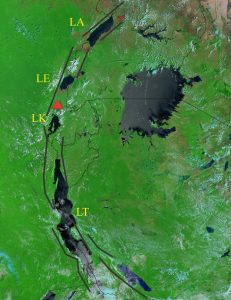
Rift basins, ocean basins, and passive margins form a dynamic continuum within the framework of plate tectonics. This post looks at the dynamic – continental rifting and development of nascent oceanic crust in the iconic East Africa Rift System.
Passive margins contain some of the thickest, most extensive sedimentary accumulations on Earth; continent-parallel lengths are measured in 1000s of kilometres, their thickness more than 10 km. They form at the trailing edge of rifted continental margins; modern configurations underlie shelves and platforms, and adjacent slope. Their seaward limits merge with the ocean abyss. From a geodynamic perspective they represent the transition from continental to oceanic lithosphere.
Passive margins are part of a geodynamic continuum, beginning with continental rifts that eventually broaden via seafloor spreading from nascent, thermally warm oceanic lithosphere to older, colder ocean basins. The plate tectonics perspective describes them as the product of ‘rift-drift’. Actualistic examples of a continental rift, and nascent passive margin and ocean basin are found in the East African Rift System (EARS) and its confluence with Red Sea and Gulf of Aden (a plate boundary triple junction).
Continental rifts
Life as a continental rift begins with stretching of crust and lithosphere mantle, often accompanied by an upwelling mantle plume. The location and trend of a rift zone seems in many cases to be controlled by older structural discontinuities in the crust. The East African Rift is a good example of this pre-existing crustal anisotropy, given its coincidence with an Early Paleozoic fold belt. Continental rifts are regions of high heat flow that in many cases is manifested as volcanism and intrusion.
There are two main pathways by which rifting can be initiated:
- Passive rifting where extension is caused by far-field stresses (generated at plate boundaries but at distance from them), such that buoyant asthenosphere mantle rises passively, partly in response to isostatic compensation, and
- Active rifting, where rising mantle plumes initiate crustal stretching.
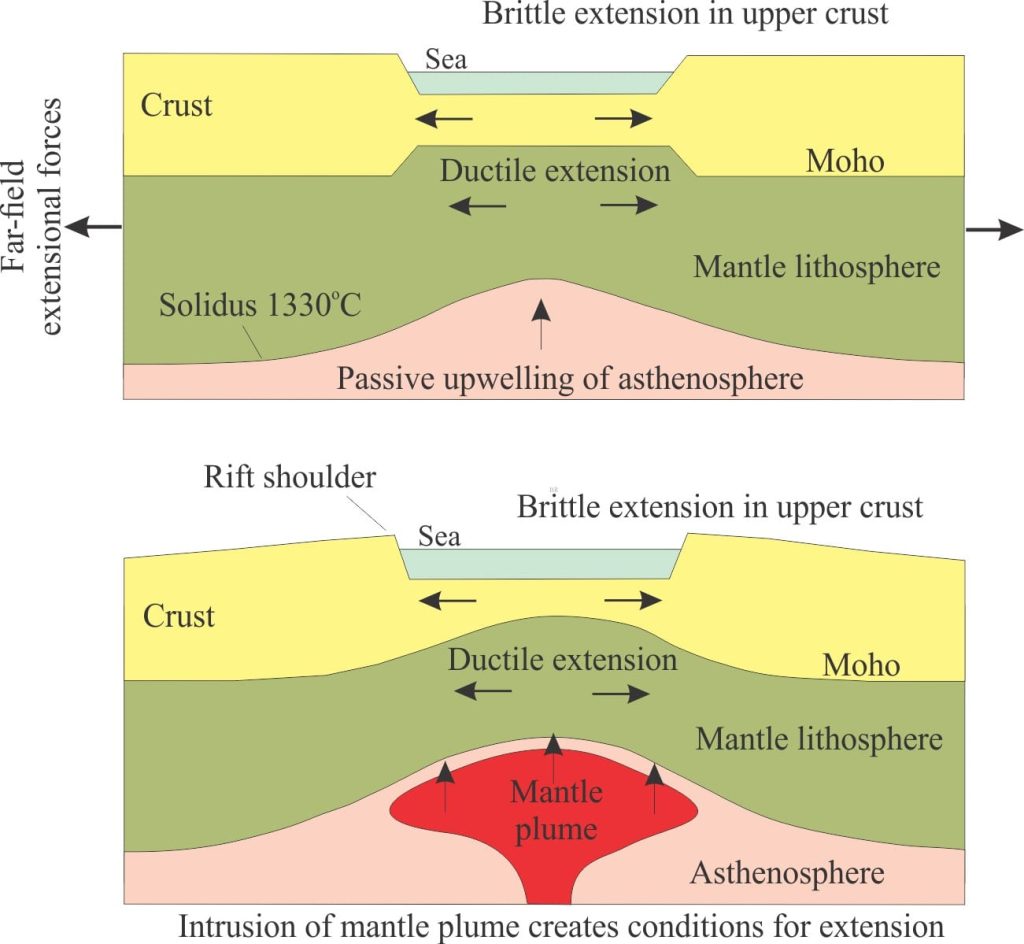
Rift basin subsidence is controlled by brittle failure in upper crustal levels, manifested as basin-margin parallel normal faulting and development of grabens. Border faults are flanked by elevated rims that can produce topographic elevations 100s of metres above the adjacent continental platform.
The grabens form discrete basins that typically fill with coarse-grained clastic sediments derived from the hanging walls of their bounding faults. Faults and fault intersections tend to focus sediment routing. Normal faulting is predominantly listric and fault block rotation during sedimentation results in local stratigraphic discordances. Flank uplifts provide a huge gradient advantage for sediment delivery to the adjacent alluvial and lacustrine settings. Local volcanism ranges from quietly effusive to catastrophic plinian eruptions; they contribute lava flows and volcaniclastics to the local stratigraphy as well as shape rift valley topography. In arid climates, evaporites accumulate in lakes, or marine deposits where there is access to seawater. Lakes, like many in the EARS have extreme chemistries, being either highly alkaline with pH >12 or hyper-acidic (pH < 1).
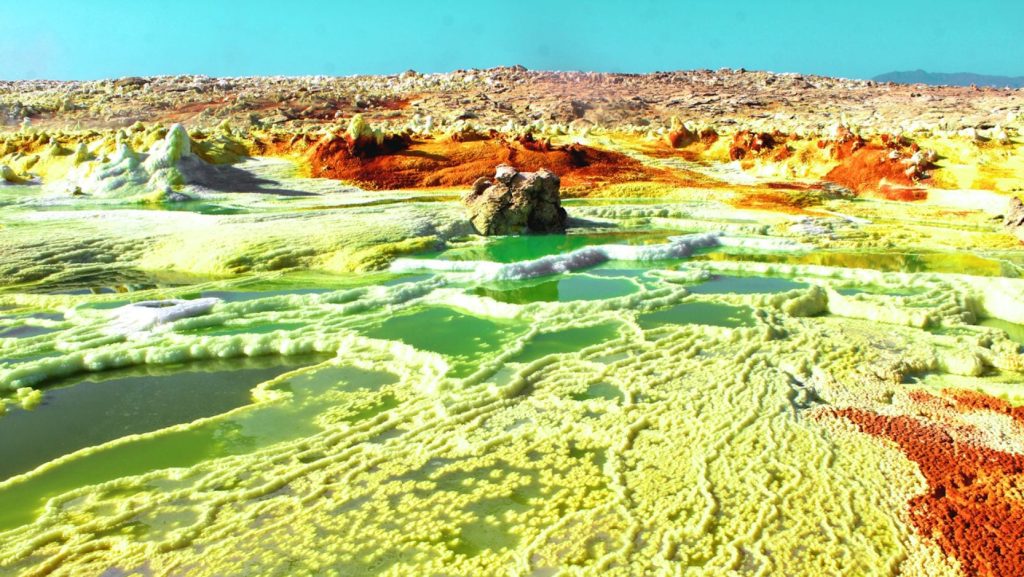
The transition to passive margin and sea floor spreading
At some point, active rifting of continental lithosphere ceases; the former axis of stretching and brittle failure approximates the axis of sea floor spreading and the production of oceanic lithosphere. This is the drift stage that also sees the accumulation of a thick passive margin succession on the trailing edge of the continental block. This transition is accompanied by lithospheric cooling and a change in the subsidence mechanism from predominantly brittle failure to flexural. Stratigraphically the transition is represented by an unconformity, often called a break-up unconformity.
McKenzie’s pure shear model
One of the earliest numerical geodynamic models to explain the transition was D. McKenzie’s (1978) Steer’s Head model; it us still used as the starting point for more recent models (nicely summarized by Allen and Allen, 2013) – it involves passive rifting. It has been superseded by more sophisticated models, but it serves as a good introduction to understanding the evolution of rift basins and passive margins.
Three important boundary conditions apply to this model (later models change these conditions):
- Stretching is uniform and symmetrical, and
- There is no rotation of rifted blocks which means conditions of pure shear apply.
- Airy isostasy applies.
In McKenzie’s model, initial rift-related subsidence is instantaneous. Faulting is dependent on crustal thickness and the amount of stretching that is expressed as β, the stretching factor. β is defined as the ratio of the stretched width and original width. At this point, heat flow in the crust and mantle lithosphere is at some maximum value.
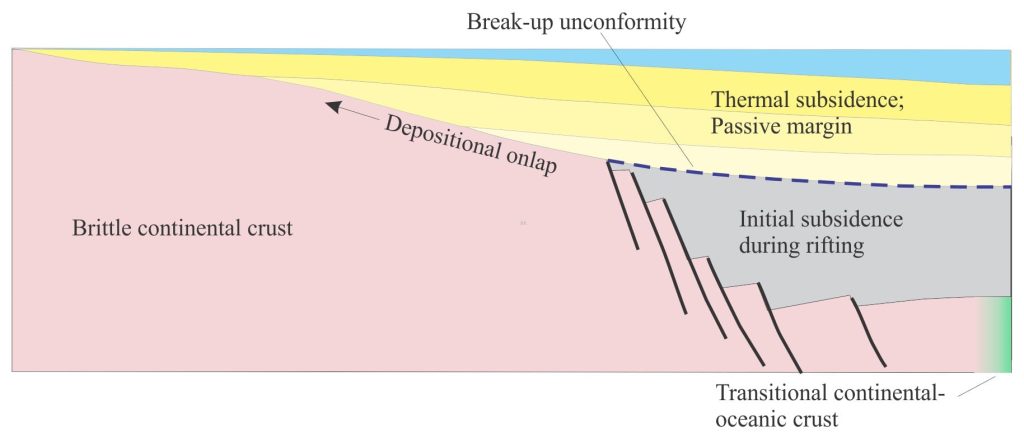
The cessation of stretching coincides with the production of oceanic lithosphere and sea floor spreading. The drifting margin begins to cool but unlike the instantaneous stretching, cooling is time-dependent and exponential. Coincident with cooling is the densification of lithosphere and this requires isostatic compensation that results in thermal subsidence. The addition over time (100-200 million years) of water and sediment is part of the isostasy equation.
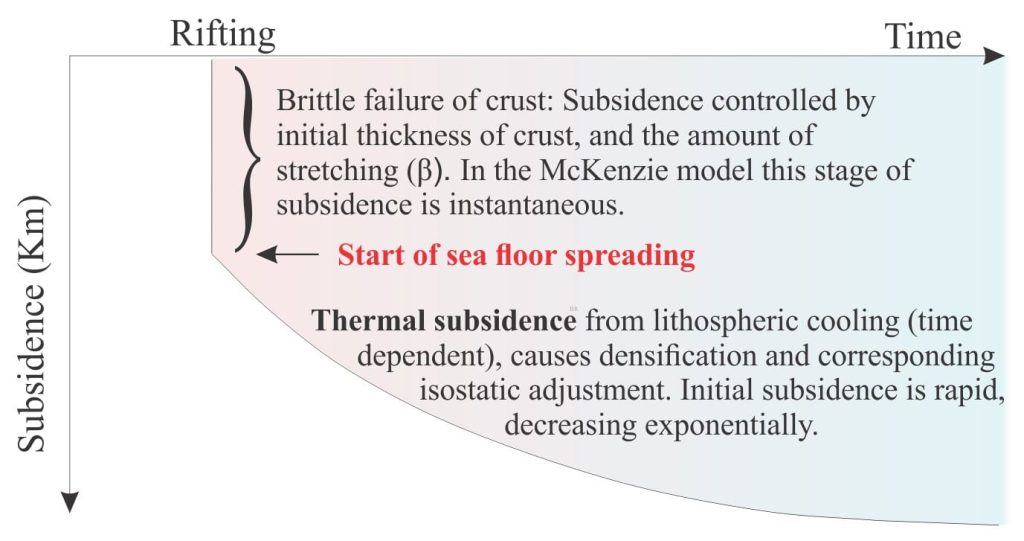
Wernicke’s simple shear model
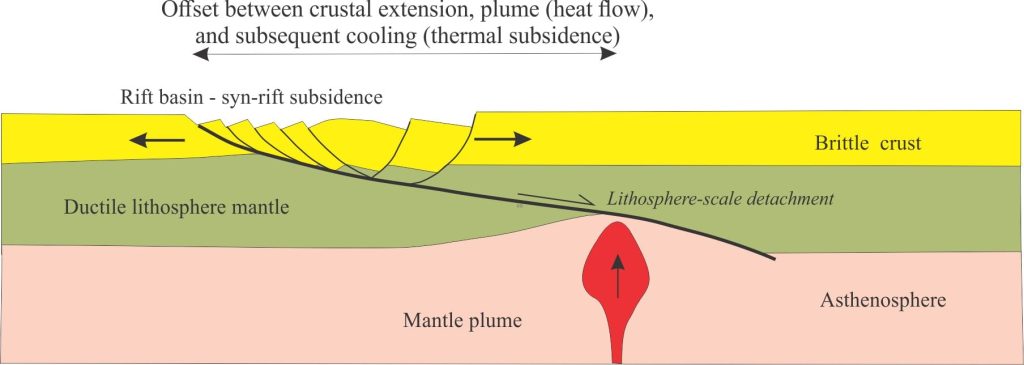
This is one of the early modifications to McKenzie’s model. In contrast, it is asymmetrical and involves simple shear. It is also passive, in that asthenospheric upwelling passively responds to stretching.
Wernicke’s model (1981) of initial continental rifting employs a major, low-angle detachment (in this case a normal fault or shear zone) that extends from the surface to the base of the mantle lithosphere. Displacement along the detachment induces crustal thinning and brittle failure that is manifested as a series of inward-dipping listric faults. Concomitant displacement in the mantle lithosphere is by ductile flow. The geometric requirements of displacement along the main detachment also mean that crustal blocks rotate. Lithospheric thinning also requires isostatic adjustment that is accomplished by (passive) asthenosphere upwelling, and rift subsidence. However, this introduces another critical difference between the two models. In the Wernicke model, extension in the upper crust occurs in the hanging wall of the detachment, but in the footwall at depth in the mantle lithosphere; this means that upwelling asthenosphere is displaced from the main region of rift basin subsidence. This implies that the rift basin will experience little or no volcanism.
EARS – the archetypal continental rift
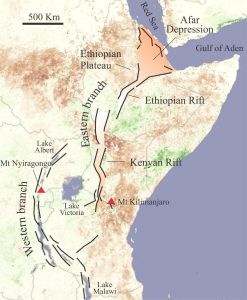
The EARS extends more than 5000 km south from its triple junction with the Red Sea – Gulf of Aden confluence. It defines a geologically young rift boundary between the African (Nubian) and Somalian-Indian plates. It is not a continuous, coherent zone of crustal stretching, but contains several rifts that comprise two main sectors: a volcanic Eastern branch that includes the Afar Triangle, Ethiopian Rift and Kenya Rift, and a younger Western branch that is less volcanic, and extends from Lake Albert, south in a gentle arc to Lake Malawi. Volcanism and high heat flow are generated by mantle plumes that are hypothesized to be part of a much larger African Superswell (mantle) that underlies much of Africa.
Celebrated volcanoes include Kilimanjaro at the south end of Kenya Rift (Eastern Branch of EARS), a 5885 m behemoth that is a composite of three stratovolcanoes. Its last eruption was about 150,000 years ago. It is associated with more than 250 satellite cones along the rift zone.
Nyiragongo volcano, south of Lake Kivu in the Western branch, is one of the more active stratovolcanoes with the world’s largest caldera lava lake. It erupts very fluid, ultramafic lavas, very low in silica (not many feldspars). Geologist Chris Jackson (Univ. Manchester) recently abseiled into the active crater; check out this video account!
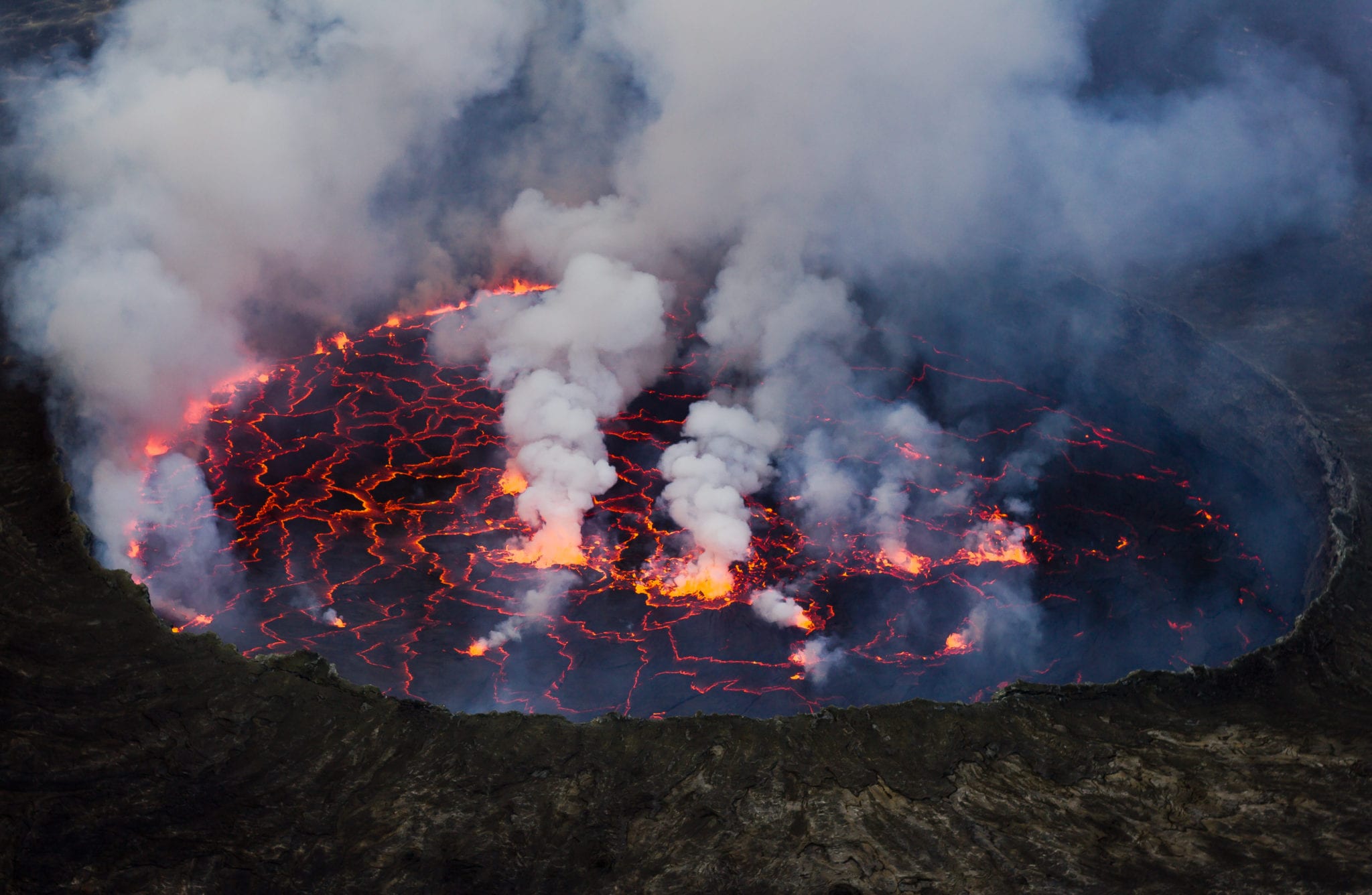
Rifting has progressed from north to south, with mature continental lithosphere extension in the Afar region that appears to be in transition to sea floor spreading. The rate of southwards rift propagation has been estimated between 25-50 mm/year.
The difference in rift maturity between the Ethiopian and Kenyan sectors, along the length of the Eastern Branch, is illustrated by their geothermal and rheology profiles. In the Ethiopian sector, lithospheric strength is contained entirely in the crust.
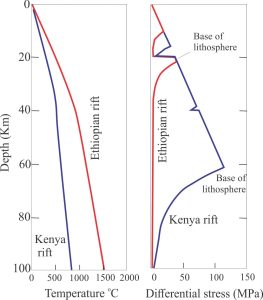
Evidence from earthquake focal mechanisms suggests that rifting is still propagating southwards. Incipient sea-floor spreading and production of oceanic crust is taking place in southern Red Sea and Gulf of Aden.
Here is a generalised timeline for EARS development (Info gleaned from U. Ring, 2014; J. Chorowicz, 2005; W. Bosworth, 2015:
- Activity in the Eastern branch began about 31 Ma (Oligocene) with mantle hotspot effusion of trap-like lava flows in Afar Depression, indicating either incipient extension from far-field stresses that allowed magma to rise, or extension generated by the rising mantle plume. Rifting in the Gulf of Aden began soon after (29.9 – 28.7 Ma), and Red Sea (27.5 – 23Ma).
- Volcanism and normal listric faulting initiated in the North Kenya region about 20Ma.
- Active rifting in the Western branch lagged that of the Eastern, beginning 12.6Ma.
- Volcanism and extension in Ethiopian Rift at 11 Ma (between Afar and North Kenya). Ethiopian Rift is the northernmost sector of the Eastern Branch of EARS.
- Between 11 and 2 Ma the centre of Ethiopian Rift extended about 20 km. Lithosphere mantle appears to have thinned drastically (based in seismic data). Since 2 Ma deformation and volcanism have concentrated along the rift axis.
- At present, in Afar Depression we appear to be witnessing the transition from continental extension to incipient sea floor spreading; sea floor spreading is already underway in southern Red Sea and Gulf of Aden with concomitant development of passive margins.
A companion post – Nascent conjugate, passive margins looks at the progression of continental rifting to nascent sea floor spreading in Red Sea, more advance accumulation of oceanic crust in Gulf of Aden, and the beginnings of conjugate passive margins. Afar Depression is a triple point for these three rift systems.
Topics in this series
Sedimentary basins: Regions of prolonged subsidence
The rheology of the lithosphere
The thermal structure of the lithosphere
Isostasy: A lithospheric balancing act
Classification of sedimentary basins
Nascent conjugate, passive margins
Basins formed by lithospheric flexure
Accretionary prisms and forearc basins
Basins formed by strike-slip tectonics
Allochthonous terranes – suspect and exotic
Source to sink: Sediment routing systems

















